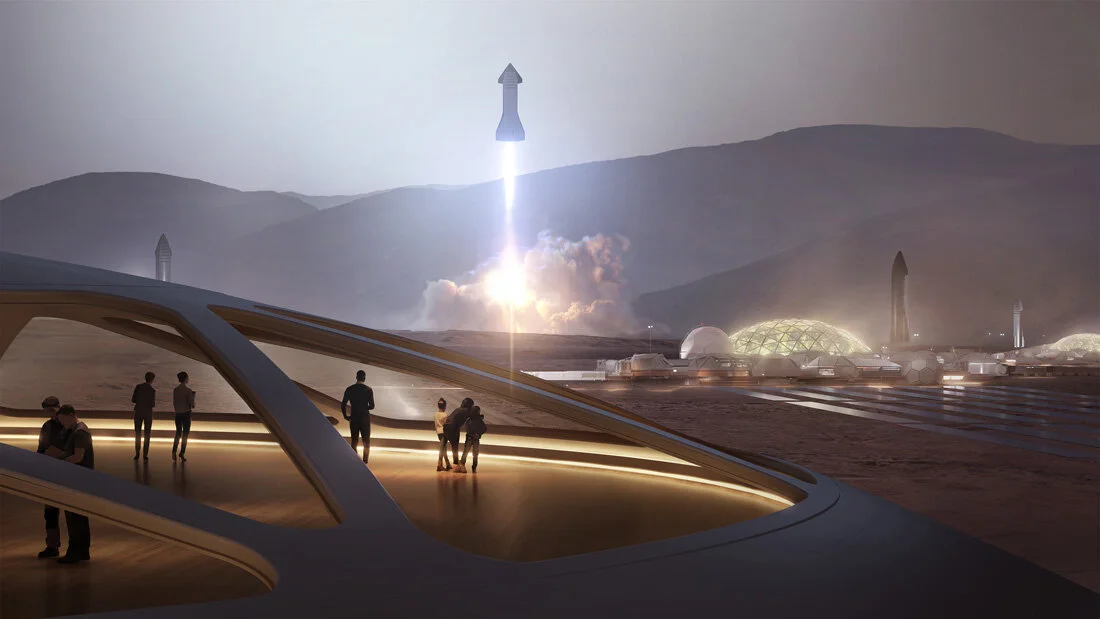Elon Musk’s dream of building a city on Mars
You want to wake up in the morning and think the future is going to be great - and that’s what being a spacefaring civilisation is all about. It’s about believing in the future and thinking that the future will be better than the past. And I can’t think of anything more exciting than going out there and being among the stars.
Elon Musk
Gwynne Shotwell, President and COO of SpaceX, has made clear: “Elon founded this company with the entire purpose of building a space transportation capability that would allow humans to move to other planets.”
Thinking ahead, we either stay living exclusively here on Earth or else we become a spacefaring civilisation and a multiplanetary species. The latter option makes best sense as a precaution against some future mass extinction event, a catastrophic World War 3 scenario, or a gradual decline of society.
Elon Musk and SpaceX aim to build a self-sustaining city on Mars Credit: NASA/JPL-Caltech
Mars is the obvious first step in us becoming a multiplanetary species. It’s a neighbouring planet, with decent sunlight. Its atmosphere is primarily CO2, with some nitrogen and argon and a few other trace elements, so it would be possible to grow plants on Mars just by compressing the atmosphere. Gravity on Mars is about 38% that of Earth, so humans could lift heavy things and bound around. And the day length is similar to what we have here on Earth.
Elon Musk realised that, in order to get to Mars, for the purpose of building a self-sustaining city there, it was necessary to design the world’s biggest ever launch vehicle - and, as importantly, make it fully reusable for reducing the costs of such an undertaking. SpaceX are already leading the way in reusable rockets, with multiple launches and landings of their Falcon 9 first-stage booster happening every week or two. Starship and its Super Heavy booster are being developed to be fully reusable, with prototype testing in progress as we’ve reported here and elsewhere in this section of our website. Starship is the spacecraft that will transport humans and cargo to Mars.
A future Mars colony (artist’s concept) Credit: SpaceX
During a livestream event with the Mars Society in October 2020, Musk explained his reasoning for reusable rockets:
You first have to say “What’s the goal?” And once you have “What’s the goal?” you can then measure the various designs against that goal. So the goal is get enough tonnage to Mars and enough people to make Mars self-sustaining as quickly as possible. We’re gonna need a lot of tonnage - maybe a hundred thousand tons, maybe a million tons. So you can’t be faffing around with these expendable rockets. They’re a joke. They’re absurd. Even Saturn V [Apollo missions] is tiny potatoes.
Expendable rockets are utterly stupid. They’re a complete waste of time. People should stop wasting their time. If you try to sell an expendable plane, people would laugh you out of the room. If you’re trying to sell an expendable car, they would laugh you out of the room.
There are advantages to size and you can certainly see this in many walks of life. If you’ve got a truck that’s carrying cargo, it’s more efficient to have a big semi-truck, not a bunch of little trucks. For ships, it would be pretty silly to see containers going across the ocean one at a time with outboard motors. That would be silly. You put them on a container ship. You have big ships, not little tiny ships. So size matters. It really does. And full reusability matters.
Musk has identified the big aim of Mars as the motivation behind SpaceX’s “forcing function for radical innovation”.
The main objective for the first few Starship missions will be to build a propellant plant to make propellant, leveraging Mars’ natural resources. It’s likely they’ll also carry rovers packed with science experiments, generating funding.
We’ve got to mine some ice. And you’ve got CO2 from the atmosphere, so from the ice you’ve got the H2O. Combine that H2O with the CO2, you get CH4 [methane] and O2 [oxygen].
And that’s why SpaceX has developed new Raptor engines fuelled by liquid oxygen (LOX) and methane, rather than the traditional rocket fuel of LOX and rocket propellant grade kerosene.
Starship Mars reentry (artist’s concept) Credit: SpaceX
A launch window for Mars comes around every 26 months. Musk has stated he wants to get a Starship off to Mars by 2024, and that he is “highly confident” SpaceX will launch a crewed mission to Mars in 2026. Of course, that could be “Elon time” and these ambitious targets could slip by two or even four years if major problems are exposed during orbital flight testing. But SpaceX are undoubtedly moving forward at a pace never seen before in the rocket industry.
A mission to Mars will require orbital refuelling. So, first, a Starship is launched, reaches orbit, and separates from its Super Heavy booster, which returns to Earth for reuse. A second Starship is then launched, carrying fuel for the first Starship’s long journey to Mars. A journey to Mars typically takes about six months, but SpaceX have plans to make this duration shorter.
A Starship takes off from Mars (artist’s concept) Credit: SpaceX
The goal is to establish a self-sustaining city on Mars by 2050 - populated by a million people - with a predicted cost of between $100 billion and $10 trillion, which includes the cost of travel and cargo. Musk has indicated he’d initiate a “major disbursement” of his Tesla stock to help fund this huge amount and realise his dream.
Commenting on the Mars project, Gwynne Shotwell has said: “This is definitely going to happen.” She’s also made clear: “Life is not going to be easy on Mars for the first few decades, for sure.”
Written by Iain Scott, 21st May 2021



